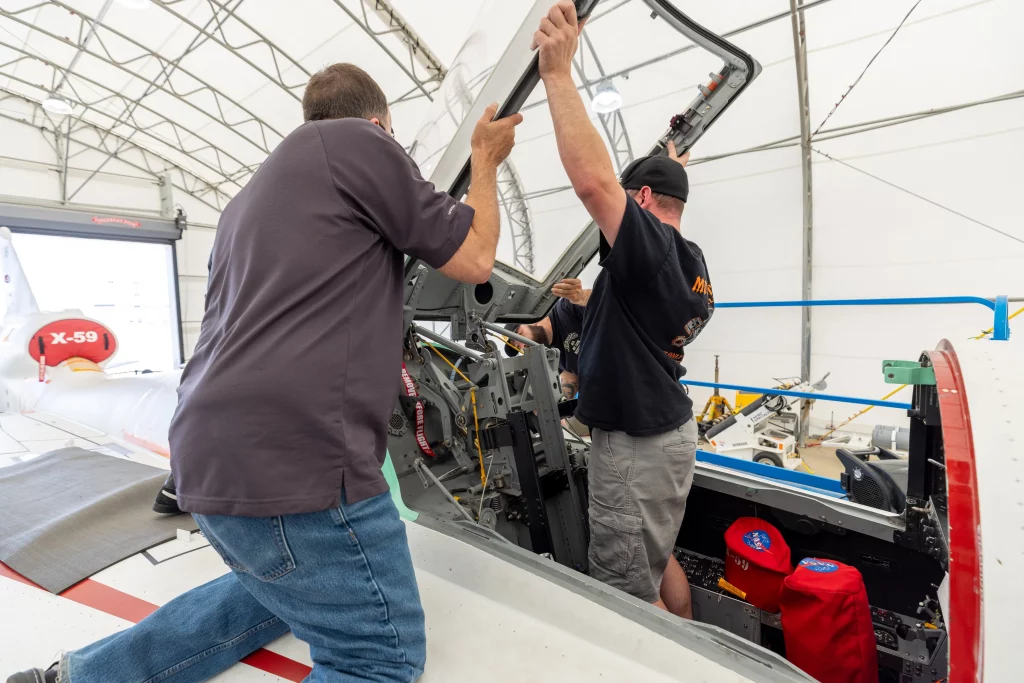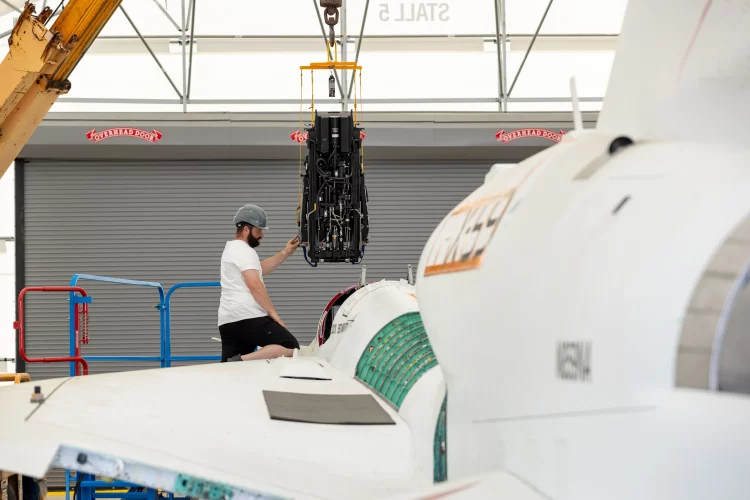Introduction
The quest for supersonic flight has long fascinated engineers, scientists, and aviation enthusiasts alike. The promise of traveling faster than the speed of sound offers significant benefits, from reducing travel times to enhancing global connectivity. However, achieving supersonic speeds while minimizing the disruptive sonic booms has been a formidable challenge. NASA’s X-59 QueSST (Quiet SuperSonic Technology) aircraft represents a groundbreaking step forward in addressing this challenge. This article delves into the latest developments in the X-59 program, highlighting its technological innovations, testing phases, and the potential impact on the future of aviation.
1. The Genesis of the X-59
The X-59 QueSST is a key component of NASA’s efforts to develop technologies that make supersonic flight quieter and more feasible. The aircraft is part of NASA’s Advanced Air Vehicles Program and is designed to address one of the most significant obstacles to commercial supersonic flight: the loud sonic boom.
1.1 Historical Context
Supersonic flight has a storied history, with notable milestones including the Concorde, which entered service in 1976 and demonstrated the commercial potential of supersonic travel. However, the sonic boom produced by the Concorde and other supersonic aircraft led to noise complaints and restricted overland supersonic travel.
1.2 Objectives of the X-59
The X-59 aims to revolutionize supersonic travel by:
- Reducing Sonic Boom: The primary goal is to minimize the sonic boom to a mere “sonic thump” that is less disruptive to people on the ground.
- Advancing Supersonic Technology: The X-59 is also designed to test and validate technologies that could pave the way for future commercial supersonic aircraft.
2. Design and Technology of the X-59
The X-59 is a marvel of modern aerospace engineering, incorporating advanced technologies and innovative design features to achieve its mission.
2.1 Aerodynamic Design
The aerodynamic design of the X-59 is crucial for achieving its goals:
- Long, Narrow Nose: The X-59 features a long, pointed nose designed to reduce the intensity of the shockwaves that cause the sonic boom.
- Delta Wing Configuration: The aircraft’s delta wing shape enhances aerodynamic efficiency and stability during supersonic flight.
- Rear-mounted Engine: The engine is positioned at the rear of the aircraft to further reduce noise and mitigate the impact of the sonic boom.
2.2 Noise Reduction Technologies
Several technologies are employed to minimize the noise generated by the X-59:
- Advanced Engine Design: The engine is designed to operate quietly while providing the necessary thrust for supersonic speeds.
- Structural Innovations: The aircraft’s structure is optimized to minimize vibrations and noise, contributing to a quieter overall operation.
- Acoustic Treatment: Specialized materials and designs are used to absorb and dissipate sound waves, further reducing the noise footprint.
2.3 Avionics and Control Systems
The X-59 is equipped with cutting-edge avionics and control systems:
- Flight Control Systems: Advanced flight control systems ensure precise handling and stability at supersonic speeds.
- Navigation and Communication: The aircraft is equipped with state-of-the-art navigation and communication systems to support its operations and data collection.
3. Testing and Development Phases
The development of the X-59 involves a series of rigorous testing phases to ensure its performance and safety.
3.1 Ground Testing
Ground testing is an essential phase in the development of the X-59:
- Structural Testing: The aircraft undergoes tests to verify the integrity of its structure and ensure it can withstand the stresses of supersonic flight.
- Systems Testing: Various systems, including avionics, propulsion, and control systems, are tested on the ground to confirm their functionality and reliability.
3.2 Wind Tunnel Testing
Wind tunnel testing plays a crucial role in evaluating the X-59’s aerodynamic performance:
- Supersonic Wind Tunnels: The aircraft is tested in supersonic wind tunnels to simulate the conditions it will experience during flight and to refine its design.
- Data Collection: Data collected during wind tunnel tests help engineers make adjustments and improvements to the aircraft’s design.
3.3 Flight Testing
Flight testing is the final and most critical phase of development:
- Initial Test Flights: The X-59 will undergo a series of initial test flights to evaluate its performance and gather data on its handling, stability, and noise levels.
- Supersonic Flight Testing: The aircraft will be tested at supersonic speeds to assess its ability to achieve and maintain these speeds while producing minimal noise.
4. Collaborative Efforts and Partnerships
The development of the X-59 involves collaboration with various partners and organizations.
4.1 Industry Partners
NASA collaborates with several industry partners to support the X-59 program:
- Lockheed Martin: The primary contractor for the X-59, responsible for the design, development, and construction of the aircraft.
- Other Aerospace Companies: Various aerospace companies contribute to specific aspects of the aircraft’s development, such as engine design and avionics.
4.2 Government and International Collaborations
The X-59 program also involves collaborations with government agencies and international partners:
- Federal Aviation Administration (FAA): The FAA is involved in regulatory aspects and will play a role in assessing the X-59’s impact on air traffic and noise regulations.
- International Space Agencies: Collaborations with international space agencies and research organizations contribute to the program’s success.

5. Impact on Future Aviation
The successful development and deployment of the X-59 have the potential to transform the aviation industry and change the way we think about supersonic travel.
5.1 Commercial Supersonic Flight
The X-59’s advancements in quiet supersonic technology could pave the way for commercial supersonic aircraft:
- Reducing Travel Times: Supersonic travel could significantly reduce flight times, making long-haul flights faster and more efficient.
- Expanding Air Travel: With reduced noise impact, supersonic aircraft could operate overland routes, expanding the possibilities for air travel.
5.2 Environmental and Regulatory Considerations
The development of quieter supersonic aircraft addresses some of the environmental and regulatory challenges associated with supersonic flight:
- Noise Reduction: By minimizing the sonic boom, the X-59 helps mitigate one of the primary concerns related to supersonic travel.
- Environmental Impact: The aircraft’s design incorporates fuel-efficient technologies that contribute to reducing its overall environmental impact.
5.3 Inspiring Innovation
The X-59 program serves as an inspiration for future innovations in aerospace technology:
- Advancements in Aerodynamics: The technologies developed for the X-59 could lead to new advancements in aerodynamics and aircraft design.
- Encouraging Research: The program encourages further research and development in supersonic and hypersonic flight technologies.
6. The Road Ahead: Key Milestones and Future Developments
The X-59 program is on a path to achieving several key milestones as it progresses toward its ultimate goal.
6.1 Upcoming Test Flights
The next phases of testing will include:
- Expanded Flight Testing: Additional flight tests will provide more data on the aircraft’s performance and noise levels.
- Public Demonstrations: The X-59 is expected to participate in public demonstrations to showcase its capabilities and gather feedback from the aviation community and the public.
6.2 Preparation for Operational Use
As the X-59 completes its testing phases, preparations will begin for its potential operational use:
- Integration into Air Traffic Systems: The aircraft will be integrated into existing air traffic management systems to ensure safe and efficient operations.
- Commercial Partnerships: Partnerships with commercial operators will be explored to transition from experimental flights to practical applications of the technology.
7. Conclusion
The arrival of the primary instrument for NASA’s X-59 QueSST marks a pivotal moment in the quest for quieter supersonic flight. The X-59 represents a significant leap forward in aerospace technology, combining innovative design features, advanced noise reduction technologies, and rigorous testing to address the challenges of supersonic travel. As the program progresses through its testing phases and moves toward operational use, the X-59 has the potential to transform the aviation industry, reduce travel times, and inspire future innovations in aerospace technology. The successful implementation of this groundbreaking technology promises to bring us closer to a new era of supersonic flight, with quieter and more efficient aircraft shaping the future of air travel.


















































Discussion about this post